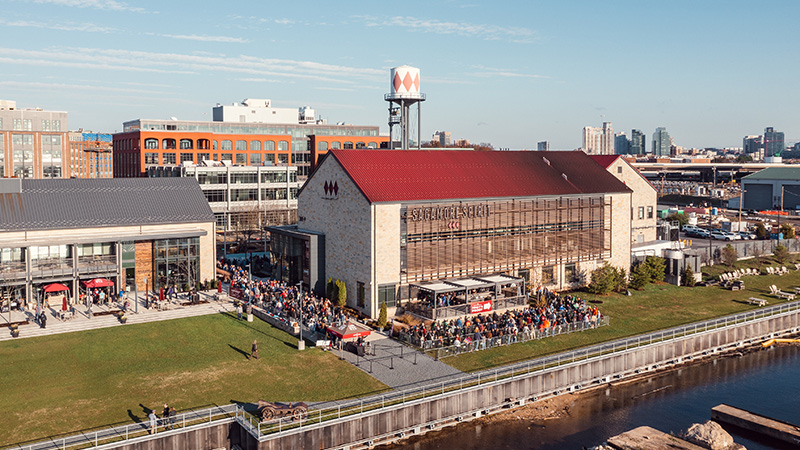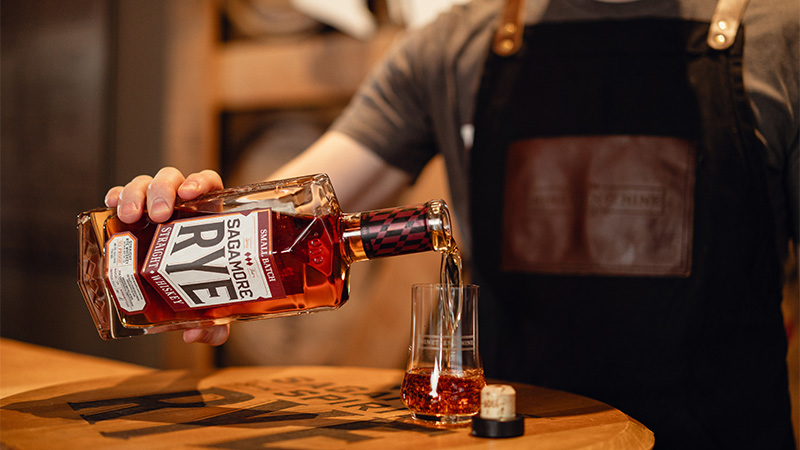
When Sagamore Spirit established its distillery on Baltimore’s Patapsco River waterfront in 2017, Ryan Norwood — now Sagamore’s vice president of operations — knew the brand faced an uphill climb. Once an epicenter of American whiskey production, Baltimore’s distilling industry and the “Maryland style rye whiskey” that Sagamore aimed to resurrect had all but vanished in the decades following Prohibition. “When we first started the brand, we were beating the drum for ‘Maryland rye,’” Norwood says. “And at the time, anybody outside of the Mid-Atlantic was like: ‘What are you talking about?’”
Eight years later, Maryland rye is firmly back on the global whiskey map in no small part due to Sagamore’s persistent efforts to bring the Old Line State’s distinctive style of rye — somewhat sweeter and rounder than traditional Pennsylvania or New York-style ryes — back to the fore. With hundreds of international spirits awards to its name and its first 100% Maryland-made rye now rolling out globally, Sagamore is on a mission to reclaim Maryland rye’s storied place in the American whiskey pantheon.
That mission began with the not-so-simple task of developing a new incarnation of the region’s signature rye whiskey without many signposts to guide the way. Maryland rye whiskey enjoyed broad popularity from the late 18th century until Prohibition pushed it into obscurity, and the historical record offers plenty of clues to its flavor profile. But the historical record does not supply a singular recipe for recreating it, because no singular recipe existed.
“There was no set definition around Maryland rye,” Norwood says. “There’s no exact mash bill, and there’s actually a lot of interpretation around what Maryland rye was. But we know that historically Maryland distillers used more corn in their process, and that makes sense when you consistently see it referenced as slightly sweeter and more balanced than other ryes of the era.”
Maryland rye likely diverged from the brawnier, spicier whiskeys hailing from points north due to various differences in climate, local water sources, and distillation techniques. But distillers’ ready access to corn in Maryland during the late 18th century likely played a significant role in setting the region’s rye whiskies on their own unique path.
“Today corn is grown in Pennsylvania and even up into New York,” Norwood says. “But during the 1700s, Maryland was one of the northernmost states growing corn at that time. I think that’s why it started finding its way into a lot of Maryland whiskeys, providing that touch of sweetness compared with many Pennsylvania ryes.”
Sagamore’s distillery team takes a decidedly modern approach to achieving its traditional Maryland rye profile. It starts by creating two distinct rye whiskeys. The first is a traditional high rye, with just five percent malted barley in the mash bill. The second recipe includes a significant amount of corn in the recipe, producing a sweeter — but still rye-dominant — spirit. Each mash is cooked, fermented, triple-distilled, and aged separately prior to blending, allowing Sagamore to carefully manage the balance of the finished whiskey.
The resulting whiskey pays homage to Maryland’s centuries-old distilling tradition via a thoroughly modern process. It also lives up to Sagamore’s “Made in Maryland” ethos. Sagamore sources a full 100% of the non-GMO corn needed for its low rye whiskey from Sagamore farm. It also partners with local Maryland agricultural communities to grow and harvest much of its rye grain, covering farmers’ upfront seed costs and contracting to purchase their future harvests.
All of this has allowed Sagamore Spirit to tick the box on a goal the team set when it opened its distillery doors back in 2017. Like most startup whiskey producers, Sagamore relied on contract distilled spirits to craft its earliest releases, as the distillery’s own Maryland-made spirits needed time to mature in the barrel. But with eight years of distillation and aging behind it, Sagamore now has enough mature whiskey on hand to produce 100% Maryland-made spirits at scale.
Last year’s launch of Sagamore Small Batch Rye Whiskey marked the distillery’s first global release of a rye whiskey distilled, aged, and bottled entirely by Sagamore in Maryland. Sagamore Cask Strength Rye Whiskey is following directly behind, with 100% Maryland made releases hitting shelves globally this year.
That means two of Sagamore’s three core whiskeys — the third is Sagamore Double Oak Rye — are now 100% Maryland made and available worldwide, a significant achievement for a distillery determined to ignite a global Maryland rye renaissance. “It’s something we’re very proud of, and we’re screaming it from the mountaintops because it’s such a milestone for us,” Norwood says. “We’ve been talking about this moment for eight years.”
This article is sponsored by Sagamore Spirit.


